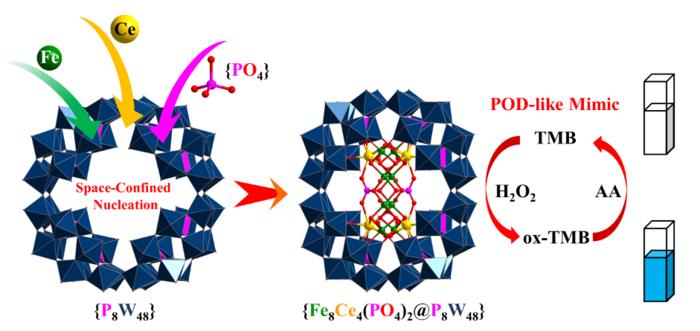By design, synthetic molecules typically have specific jobs to prevent or accelerate reactions between other molecules. To help control more complicated reactions, researchers may harness spare space in one molecule to synthesize another chemical structure. The host-guest assembly can better induce the specific desired reaction than either component individually — if the scientists designing the assembly get it right.

Credit: Polyoxometalates, Tsinghua University Press
By design, synthetic molecules typically have specific jobs to prevent or accelerate reactions between other molecules. To help control more complicated reactions, researchers may harness spare space in one molecule to synthesize another chemical structure. The host-guest assembly can better induce the specific desired reaction than either component individually — if the scientists designing the assembly get it right.
A multi-institution team based in China has reported a novel cluster — the guest — that nucleated inside of a polyoxometalate (POM) nanoreactor — the host. The resulting host-guest assembly has enhanced peroxidase-like activity, meaning it could help accelerate reactions involving the decomposition of H2O2. These reactions are critical in biological processes, such as protecting genetic material from oxidation damage, and have implications for advanced biotechnological processes, according to the researchers.
They published their work in Polyoxometalates on March 4.
“The advantages of space-confined synthesis are not limited to the customization of shape, size and composition, but of precise crystal orientation and spatial position of desired products,” said corresponding author Peng Yang, professor in the College of Chemistry and Chemical Engineering, Advanced Engineering Research Center of the Ministry of Education, Hunan University. “From nanotechnology to crystal engineering, a multitude of chemical forces have been employed to steer the confined growth of guest components within the host containers, such as carbon nanotubes or metal-organic framework/cages.”
The POM is a molecular framework that consists of multiple metal ions and shared oxygen atoms with a cavity at the center. In this cavity, researchers synthesized a novel multicomponent cluster using positively charged ions of iron and cerium, as well as phosphate. The cluster nucleated, meaning it formed a cluster with a clear center, in the POM’s cavity.
“We found that novel structures of polyoxometalates can be obtained by confining the synthons within specific nanospaces, and the confined synthetic method excels at allowing us to take advantage of those nanospaces,” Yang said, explaining that synthons are not a reagent but can signal the start of a reagent needed to synthesize a target molecule. “Within the cavity of this polyoxometalate, we successfully nucleated this novel cluster for the first time.”
The researchers analyzed the cluster’s structure and composition, as well as investigated its potential functions. According to Yang, preliminary studies on the POM cluster yielded promising results attesting to its ability to detect ascorbic acid — an antioxidant that helps protect cells from free oxygen that can inflect damage — with high sensitivity and specificity.
“This work opens up more possibilities in the development of POM-based molecular assemblies from customized synthesis via structural design to application expansion,” Yang said.
Co-authors include Hong-Xin Sheng, Bo-Yang Lin and Chao-Qin Chen, all of whom are affiliated with the College of Chemistry and Chemical Engineering, Advanced Engineering Research Center of the Ministry of Education, Hunan University; and Jing Du, who is affiliated with the Testing and Analysis Center at Hebei National University.
The National Science Foundation of Hunan Province, the Science and Technology Innovation Program of Hunan Province and the Student Innovation Training program of Hunan Province supported this research.
About Polyoxometalates
Polyoxometalates is a peer-reviewed and interdisciplinary research journal that focuses on all aspects of polyoxometalates, featured in rapid review and fast publishing, sponsored by Tsinghua University and published by Tsinghua University Press. Submissions are solicited in all topical areas, ranging from basic aspects of the science of polyoxometalates to practical applications of such materials. Polyoxometalates offers readers an attractive mix of authoritative and comprehensive Reviews, original cutting-edge research in Communication and Full Paper formats, Comments, and Highlight.
About SciOpen
SciOpen is a professional open access resource for discovery of scientific and technical content published by the Tsinghua University Press and its publishing partners, providing the scholarly publishing community with innovative technology and market-leading capabilities. SciOpen provides end-to-end services across manuscript submission, peer review, content hosting, analytics, and identity management and expert advice to ensure each journal’s development by offering a range of options across all functions as Journal Layout, Production Services, Editorial Services, Marketing and Promotions, Online Functionality, etc. By digitalizing the publishing process, SciOpen widens the reach, deepens the impact, and accelerates the exchange of ideas.
Journal
Polyoxometalates
DOI
10.26599/POM.2024.9140060
Article Title
From confined growth to enhanced peroxidase-like activity: Nucleation of a phosphate-mediated FeIII–CeIII–oxo cluster inside the {P8W48} nanoreactor
Article Publication Date
4-Mar-2024




